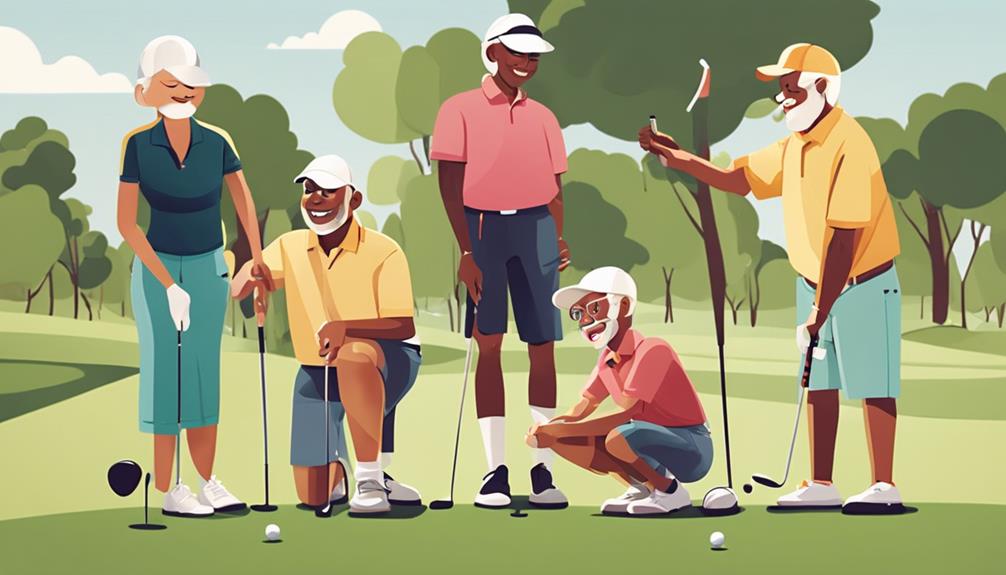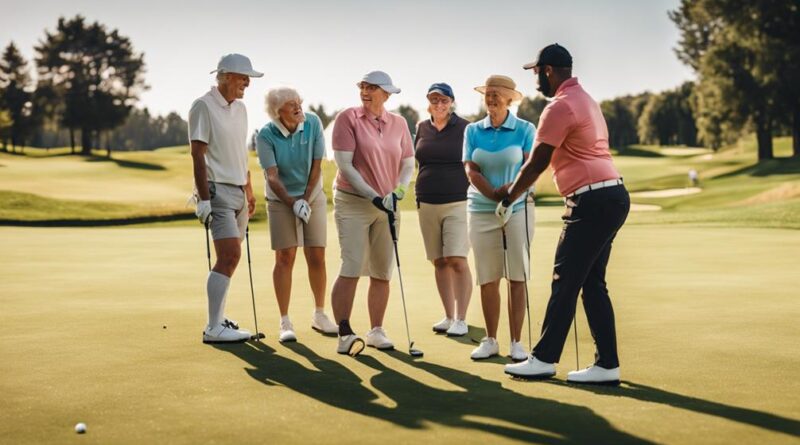10 Inclusive Golf Training Tips for Beginners
As you start your golf journey, here are ten inclusive tips to boost your skills and create a supportive golfing atmosphere. First, master club selection, grips, and posture for a strong swing foundation. Adapt techniques and equipment to match individual abilities. Foster camaraderie and offer encouragement for a positive environment. Utilize visual aids like graphics and videos for better understanding. Modify your swing for comfort and power. Embrace diverse training methods and mobility solutions. Encourage inclusivity and maintain positivity throughout practice. These tips will elevate your game while embracing diversity and camaraderie in golf.
Understanding Equipment Basics
To begin your journey in golf, it's crucial to grasp the fundamental basics of golf equipment. Club selection plays a pivotal role in your game. Understand the different types of clubs and their uses. Start with a basic set of clubs that includes a driver, irons, wedges, and a putter. Learn the purpose of each club and when to use them during a round.
Equally important is mastering the grip technique. The way you hold the club can significantly impact your swing and shot outcome. A proper grip provides stability and control throughout your swing. Experiment with different grip styles to find what works best for you. Seek guidance from a golf instructor to ensure you're using the correct grip technique.
Proper posture is key to a successful golf swing. Maintain a relaxed stance with your feet shoulder-width apart. Bend your knees slightly and keep your back straight. Your weight should be evenly distributed between both feet. Alignment adjustments are also crucial. Ensure that your body is aligned parallel to your target line. Use alignment aids such as clubs or markers to help you position yourself correctly.
Understanding these equipment basics sets a strong foundation for your golfing journey. Practice consistently and seek feedback to refine your skills further. Remember, mastering the basics leads to improved performance on the course.
Embracing Adaptive Techniques
Mastering adaptive techniques in golf can significantly enhance your game, allowing you to excel in various playing conditions and overcome challenges effectively. Adaptive techniques refer to modifications in your approach, equipment, or playing style to accommodate individual needs and abilities. In golf, these techniques can help players with physical limitations or those facing specific challenges to fully enjoy the game.
To embrace adaptive techniques, start by understanding your unique requirements and limitations. This could involve working with a coach or specialist who can recommend adjustments to your equipment or swing mechanics. For example, using clubs with larger grips can provide better stability for players with hand dexterity issues. Additionally, modifying your stance or swing to suit your physical capabilities can greatly impact your performance on the course.
Creating an inclusive environment on the golf course is essential for embracing adaptive techniques. This involves fostering a supportive atmosphere where players feel comfortable making necessary adjustments without judgment. Encouraging open communication and understanding among fellow golfers can help promote acceptance and respect for diverse playing styles.
Fostering a Supportive Environment
Creating a supportive environment on the golf course is crucial for fostering inclusivity and enhancing the overall experience for all players. One way to achieve this is by creating camaraderie among players. Encouraging friendly interactions, offering support, and celebrating each other's successes can help build a sense of community on the course. When players feel connected and supported, it can make the game more enjoyable and welcoming for everyone involved.
Building confidence is another essential aspect of fostering a supportive environment in golf. Providing positive feedback, constructive encouragement, and recognizing improvement can help boost players' self-esteem and belief in their abilities. Confidence plays a significant role in performance, and when players feel supported and confident, they're more likely to take risks, try new techniques, and ultimately improve their game.
Utilizing Visual Aids Effectively
When utilizing visual aids effectively in golf training, enhance your learning experience by incorporating clear and engaging graphics that illustrate key concepts. Color-coded diagrams can help you understand the correct stance, grip, and swing path. Interactive videos provide a dynamic way to visualize proper techniques and reinforce your understanding of each step in the golf swing. These visual aids offer a multi-dimensional learning experience that caters to different learning styles.
Clear illustrations play a crucial role in breaking down complex movements into digestible segments. By studying detailed drawings of the golf swing sequence, you can identify areas for improvement and refine your technique. Engaging apps designed for golf training can offer personalized feedback and analysis, allowing you to track your progress over time. These apps often include interactive features that simulate real-world scenarios, helping you apply theoretical knowledge to practical situations on the golf course.
Incorporating visual aids into your training routine not only makes learning more enjoyable but also accelerates your skill development. By leveraging color-coded diagrams, interactive videos, clear illustrations, and engaging apps, you can gain a deeper understanding of the fundamentals of golf and make significant strides in improving your game.
Modifying Swings for Comfort
To enhance your golf training experience, consider making adjustments to your swing for increased comfort and efficiency. When modifying your swing, it's essential to focus on flexibility modification and comfort customization to tailor your movements to your body's needs. Here are three key tips for optimizing your swing for a more enjoyable and effective golf training session:
- Flexibility Modification: Start by assessing your current range of motion and flexibility. Identify any areas of stiffness or discomfort that may be affecting your swing. Incorporate stretching exercises and mobility drills into your warm-up routine to improve flexibility in key areas such as your shoulders, hips, and spine. This increased flexibility will allow you to achieve a more fluid and natural swing motion, reducing the risk of injury and enhancing your overall performance on the course.
- Comfort Customization: Pay attention to how your body feels during each phase of your swing. Experiment with different grip sizes, club lengths, and stance widths to find the most comfortable setup for your unique physique. Adjusting these elements can help alleviate strain on your muscles and joints, allowing you to swing more freely and powerfully. Remember, comfort is key to consistency and confidence in your golf game.
- Alignment Adjustment: Proper alignment is crucial for a successful swing. Make sure your feet, hips, and shoulders are parallel to the target line to promote a straight and accurate ball flight. Use alignment aids such as alignment sticks or markers on the ground to ensure your body is positioned correctly throughout the swing. By fine-tuning your alignment, you can optimize your swing mechanics and increase your chances of hitting the ball where you intend.
Practicing Inclusive Communication
Enhance your golf training experience by focusing on practicing inclusive communication to foster a supportive and welcoming environment for all participants. Inclusive communication involves active listening and providing inclusive feedback to create a positive learning atmosphere. When engaging in conversations with fellow golfers or instructors, make sure to listen attentively to their perspectives and experiences. Acknowledge their input and respond thoughtfully, showing that their opinions are valued and respected. This not only encourages open dialogue but also helps build trust and camaraderie within the training group.
Furthermore, when giving instructions or feedback, strive to be clear and concise. Use simple and direct language to ensure that everyone understands the information being conveyed. Avoid using jargon or technical terms that may be unfamiliar to beginners. Encourage questions and be patient in providing explanations when needed. Creating a space where individuals feel comfortable asking for clarification fosters a more inclusive learning environment.
Incorporating inclusive communication practices into your golf training sessions not only enhances the overall experience but also promotes a sense of belonging and inclusivity for all participants. By actively listening, providing inclusive feedback, offering clear instructions, and promoting open dialogue, you contribute to creating a supportive and welcoming atmosphere where everyone can thrive and improve their golf skills.
Implementing Diverse Training Drills

Implementing a variety of diverse training drills can significantly enhance your golf skills and overall performance on the course. Here are three effective ways to diversify your training routine:
- Interactive Games: Incorporating interactive games into your practice sessions can make learning more engaging and fun. Games like closest to the pin challenges or putting competitions can help improve your focus, accuracy, and decision-making skills on the course. Additionally, playing these games with fellow golfers can introduce an element of friendly competition, motivating you to push yourself further.
- Team Challenges: Collaborating with other golfers to complete team challenges can simulate real on-course scenarios and enhance your ability to work under pressure. Team challenges can involve tasks like strategizing together to navigate a difficult hole or competing in a team-based long drive contest. These challenges not only build camaraderie but also help sharpen your communication and teamwork skills, which are valuable in a competitive golf setting.
- Skill Building Exercises: Integrate skill-building exercises and creative techniques into your training regimen to target specific areas for improvement. This could include drills focusing on driving distance, iron accuracy, or putting consistency. By honing in on individual skills through structured exercises, you can address weaknesses and build a more well-rounded game. Experimenting with innovative techniques can also keep your practice sessions fresh and engaging, preventing monotony and promoting continuous growth in your golf game.
Incorporating Mobility Solutions
To improve your golfing performance, consider integrating mobility solutions that cater to enhancing your physical capabilities and flexibility on the course. Accessible transportation can help ensure you reach the golf course with ease, allowing you to focus on your game rather than worrying about mobility issues.
Additionally, incorporating adaptive exercises into your training regimen can target specific areas that may need improvement, helping you move more efficiently and powerfully during your swings.
Mobility assistance tools such as golf carts designed for accessibility can provide you with the support needed to navigate the course comfortably. These solutions are invaluable in ensuring that mobility limitations don't hinder your enjoyment of the game.
Furthermore, inclusive fitness programs tailored to golfers of all abilities can help you enhance your strength, balance, and coordination, ultimately improving your overall performance on the course.
Encouraging Participation for All

Encouraging golf participation for individuals of all backgrounds and abilities is crucial for fostering inclusivity and diversity within the sport. To achieve this goal effectively, consider the following strategies:
- Accessible facilities and inclusive coaching: Providing accessible facilities such as wheelchair ramps, adaptive golf carts, and modified equipment can make the sport more welcoming to individuals with physical disabilities. Inclusive coaching practices that focus on individual strengths and adapt to different learning styles can help beginners feel supported and motivated to continue improving their skills.
- Adaptive programs and welcoming atmosphere: Developing adaptive golf programs tailored to specific needs, such as programs for individuals with visual impairments or cognitive disabilities, can create opportunities for a wider range of participants to engage in the sport. Creating a welcoming atmosphere at golf courses and training facilities by promoting diversity, respect, and understanding can help beginners feel comfortable and valued regardless of their background or skill level.
- Community outreach and partnerships: Collaborating with local organizations, schools, and community centers to promote golf as an inclusive sport can help reach individuals who may not have considered participating before. By organizing events, clinics, and beginner-friendly tournaments, you can introduce newcomers to the sport in a supportive and encouraging environment.
Promoting a Positive Mindset
Promote a positive mindset by emphasizing the importance of mental resilience and self-belief in your golf training journey. Developing a positive mental outlook is key to enhancing your performance on the course. Engage in mindfulness exercises to help you stay present and focused during your training sessions. These exercises can range from simple deep breathing techniques to more structured mindfulness practices that center your mind and calm any pre-game nerves. Incorporating mental preparation into your routine can significantly impact your overall game.
Confidence building is another crucial aspect of fostering a positive mindset. Self-affirmations can be a powerful tool in boosting your self-belief. Before stepping onto the green, remind yourself of your strengths and capabilities. Repeat positive affirmations such as 'I am a skilled golfer' or 'I am confident in my abilities' to reinforce a strong sense of self-assurance. Visualizing success can also help in building confidence. Envision yourself making successful shots and sinking putts, reinforcing a positive mindset and belief in your skills.
Frequently Asked Questions
How Do I Handle Distractions on the Golf Course?
When distractions pop up on the golf course, remember to stay focused. Practice mindful breathing to center yourself and use visualization techniques to picture successful shots. Engage in positive self-talk to boost confidence and maintain mental toughness.
Is There Specific Etiquette I Should Follow During Training?
When training for golf, it's essential to adhere to proper etiquette on the course. Wearing appropriate attire shows respect for the sport and other players.
Maintain respectful behavior by being mindful of your surroundings, keeping noise levels down, and not disturbing fellow golfers.
Following these etiquette guidelines won't only enhance your training experience but also demonstrate your commitment to the game.
What Are the Best Ways to Improve My Focus While Playing?
To enhance your focus during play, incorporate mindfulness techniques and visualization exercises. Engage in breathing exercises to center yourself and improve concentration.
Strengthen mental toughness through strategies like positive self-talk and staying present in the moment.
Can I Use Technology to Enhance My Golf Training Experience?
You can certainly use technology to enhance your golf training experience. Virtual simulations provide a realistic environment to practice and improve your skills.
Wearable devices like smartwatches or motion sensors can track your swing mechanics and provide valuable data for analysis. Embracing these technological tools can help you elevate your game and make your training sessions more effective and engaging.
Experiment with different technologies to find what works best for you.
How Can I Overcome Self-Doubt and Build Confidence in Golf?
To build confidence in golf, focus on mental toughness through visualization. Picture yourself hitting perfect shots and succeeding. Use positive self-talk to reinforce belief in your abilities.
Set achievable goals to track progress and boost confidence. Stay committed to your practice routine and trust in your skills.
Conclusion
In conclusion, by following these inclusive golf training tips for beginners, you can enhance your skills and enjoyment of the game. Remember to embrace adaptive techniques, foster a supportive environment, and utilize visual aids effectively.
Modify your swings for comfort, implement diverse training drills, and incorporate mobility solutions. Encourage participation for all and promote a positive mindset.
With dedication and practice, you can become a more confident and successful golfer. Enjoy the journey and keep striving for improvement!
